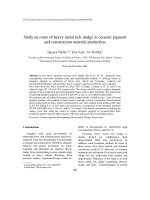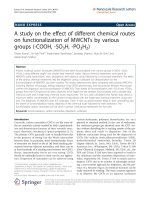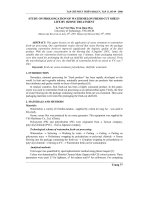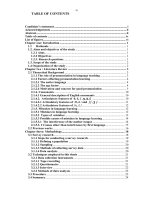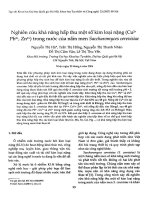Study on production of biosurfactant by strain pseudomonas using crude oil as sole carbon source
Bạn đang xem bản rút gọn của tài liệu. Xem và tải ngay bản đầy đủ của tài liệu tại đây (1.14 MB, 71 trang )
VIETNAM NATIONAL UNIVERSITY OF AGRICULTURE
FACULTY OF BIOTECHNOLOGY
GRADUATION THESIS
STUDY ON PRODUCTION OF BIOSURFACTANT
BY STRAIN Pseudomonas USING CRUDE OIL
AS SOLE CARBON SOURCE
HANOI - 2022
VIETNAM NATIONAL UNIVERSITY OF AGRICULTURE
FACULTY OF BIOTECHNOLOGY
GRADUATION THESIS
STUDY ON PRODUCTION OF BIOSURFACTANT
BY STRAIN Pseudomonas USING CRUDE OIL
AS SOLE CARBON SOURCE
STUDENT
:
LE VIET HUNG
STUDENT’S CODE
:
620391
CLASS
:
K62CNSHE
SUPERVISOR
:
DR. KIEU THI QUYNH HOA
ASSOC. PROF. NGUYEN VAN GIANG
HANOI – 2022
COMMITMENT
I hereby declare that this is my research and completion, the research
results presented in the thesis are honest, and objective, and have never been
used to present any subject project. I hereby declare that all help in the
preparation of this thesis has been thanked, and the sources of information cited
in this thesis have been acknowledged.
Hanoi, May 2022
Sincerely
Le Viet Hung
i
ACKNOWLEDGMENTS
First of all, with deep gratitude, I would like to thank Dr. Kieu Thi
Quynh
Hoa,
Department
of
Petroleum
Microbiology,
Institute
of
Biotechnology (IBT), Vietnam Academy of Science and Technology (VAST),
and Assoc. Prof. Nguyen Van Giang, Department of Microbial Biotechnology,
Vietnam National University of Agriculture (VNUA) are the person who
oriented, guided, and at the same time, helped and created the best conditions to
help me complete this thesis.
I would like to express my sincere thanks to the staff of the Department
of Petroleum Microbiology, IBT, VAST for their enthusiastic support and
guidance during the experiment to complete the experiment into a thesis.
At the same time, I would like to thank the teachers of the Department of
Microbial Biotechnology, VNUA for imparting valuable knowledge and
passion for scientific research.
Finally, I would like to sincerely thank my family and friends who have
always accompanied, cared for, and encouraged me throughout the whole
process of studying, researching, and completing the thesis.
Hanoi, May 2022
Sincerely
Le Viet Hung
ii
INDEX
COMMITMENT .............................................................................................................. i
ACKNOWLEDGMENTS ...............................................................................................ii
INDEX .......................................................................................................................... iii
LIST OF ABBREVIATIONS ........................................................................................ vi
LIST OF TABLES ........................................................................................................vii
LIST OF FIGURES ..................................................................................................... viii
ABSTRACT .................................................................................................................... x
PART I. INTRODUCTION .......................................................................................... 1
1.1.
Preface ................................................................................................................ 1
1.2.
Purpose and requirements: ................................................................................. 2
1.2.1.
Purpose ............................................................................................................... 2
1.2.2.
Requirements ...................................................................................................... 2
PART II. LITERATURE REVIEW ............................................................................ 4
2.1.
Petroleum hydrocarbon contamination (PHC) ................................................... 4
2.1.1.
Petroleum hydrocarbon contamination in the world .......................................... 4
2.1.2.
Petroleum hydrocarbon contamination in Vietnam ........................................... 5
2.1.3.
Effects of oil pollution on ecosystems and people ............................................. 6
2.1.4.
Mechanism
of
microbial
biodegradation
of
petroleum
hydrocarbons ...................................................................................................... 7
2.1.5.
Methods applied for treatment of petroleum hydrocarbon
contaminants ....................................................................................................... 8
2.2.
Biosurfactants ................................................................................................... 10
2.2.1.
Classification of biosurfactants ........................................................................ 10
2.2.2.
Characterization of biosurfactants .................................................................... 11
2.3.
Biosurfactants from microorganisms and their applications ............................ 12
2.3.1.
Microbial production of biosurfactants ............................................................ 12
2.3.2.
Effect of environmental factors on production of biosurfactants..................... 14
2.3.3.
The potential application of biosurfactants ...................................................... 16
2.4.
Study on biosurfactant producing microorganisms for petroleum
hydrocarbon biodegradation ............................................................................. 17
iii
2.4.1.
In the world ...................................................................................................... 17
2.4.2.
In Vietnam ........................................................................................................ 18
2.5.
Application of Pseudomonas in petroleum hydrocarbon pollution
treatment .................................................................................................................... 19
PART III: MATERIALS AND METHODS ............................................................. 20
3.1.
Materials ........................................................................................................... 20
3.1.1.
Bacterial strain .................................................................................................. 20
3.1.2.
Crude Oil .......................................................................................................... 20
3.1.3.
Culture media ................................................................................................... 20
3.1.4.
Machines and equipments ................................................................................ 20
3.2.
Research methods ............................................................................................. 21
3.2.1.
Isolation of bacteria using petroleum hydrocarbon as sole carbon
source ................................................................................................................ 21
3.2.2.
Selection of a bacterial strain capable of biosurfactant production
with high emulsification activity on petroleum hydrocarbon
substrate (crude oil) .......................................................................................... 22
3.2.3.
Identification of the selected bacterial strain .................................................... 22
3.2.4.
Effect of environmental and culture conditions on biosurfactant
production of the selected bacterial strain ........................................................ 24
3.2.5.
Determination of total oil content by gravimetric method ............................... 24
PART IV: RESULTS .................................................................................................. 25
4.1.
Screening of petroleum hydrocarbon (crude oil) utilizing and
bio-surfactant producing bacterial strains ........................................................ 25
4.2.
Identification of the selected petroleum hydrocarbon utilizing
and biosurfactant producing bacterial strain .................................................... 25
4.2.1.
Morphological characteristics of the DSVK2 strain ........................................ 25
4.2.2.
Classification of the DSVK2 strain by 16S rRNA gene sequence
analysis....................................................................................................................... 27
4.2.3.
The biosurfactants producing ability on crude oil of the selected
bacterial strain .................................................................................................. 27
iv
4.3.
Effect of environmental and culture conditions on biosurfactant
production efficiency of DSVK2 strain ........................................................... 28
4.3.1.
Effect of crude oil concentration on biosurfactant production
efficiency of DSVK2 strain .............................................................................. 28
4.3.2.
Effect of nitrogen sources on biosurfactant production efficiency
of DSVK2 strain ............................................................................................... 31
4.3.3.
Effect of different concentrations of NH4NO3 on biosurfactant
production efficiency of DSVK2 strain ........................................................... 33
4.3.4.
Effect of pH value on biosurfactant production efficiency of
DSVK2 strain ................................................................................................... 35
4.3.5.
Effect of temperature on biosurfactant production efficiency of
DSVK2 strain ................................................................................................... 37
4.3.6.
Effect of concentrations of NaCl on biosurfactant production
efficiency of DSVK2 strain .............................................................................. 39
4.3.7.
Effect of bacterial concentrations on biosurfactant production
efficiency of DSVK2 strain .............................................................................. 41
4.3.8.
Biodegradation of crude oil of Pseudomonas sp. DSVK2 ............................... 43
PART V. DISCUSSION .............................................................................................. 45
PART VI: CONCLUSIONS ....................................................................................... 49
REFERENCES .............................................................................................................. 50
v
LIST OF ABBREVIATIONS
Abbreviations
Explain
APG
Alkyl polyglycoside
BS
Biosurfactants
CLP
Cyclic Lipopeptide
E24
Emulsifying index after 24 hours
HC
Hydrocarbons
IBT
Institute of Biotechnology
MSM
Mineral salt medium
PAHs
Polycyclic aromatic hydrocarbons
PHC
Petroleum Hydrocarbon Contamination
SEM
Scanning electron microscope
ST
Surface tension
TABM
Total aerobic bacteria medium
TPH
Total petroleum hydrocarbon
VAST
Vietnam Academy of Science and Technology
VNUA
Vietnam National University of Agriculture
vi
LIST OF TABLES
Table 2.1. Large oil spill in the world .............................................................................4
Table 2.2. Large oil spill in Vietnam ...............................................................................5
Table 2.3. Classification of biosurfactants by microorganisms ....................................11
Table 2.4. Microorganisms capable of biosurfactant production ..................................13
Table 3.1. Equipment used for research ........................................................................21
vii
LIST OF FIGURES
Figure 2.1.
Mechanism of biodegradation petroleum ................................................ 8
Figure 4.1.
Colony morphology of DSVK2 strain on TABM ................................. 26
Figure 4.2.
Image of DSVK2 strain under scanning electron
microscope ............................................................................................. 26
Figure 4.3.
Biosurfactant of DSVK2 strain during 18 days of
incubation .............................................................................................. 28
Figure 4.4.
Biosurfactant production efficiency of DSVK2 during 18
days ........................................................................................................ 28
Figure 4.5.
Biosurfactant production of DSVK2 strain at different
concentrations of crude oil after 12 days incubation ............................. 30
Figure 4.6.
Biosurfactant producing of DSVK2 strain with different
crude oil content after 12 days incubation............................................. 30
Figure 4.7.
Biosurfactant producing of DSVK2 strain with different
nitrogen sources after 12 days incubation ............................................. 32
Figure 4.8.
Biosurfactant ability of strain DSVK2 with different
nitrogen sources after 12 days. .............................................................. 32
Figure 4.9.
Biosurfactant production of DSVK2 strain at different
concentrations of NH4NO3 after 12 days incubation............................. 34
Figure 4.10.
Biosurfactant production efficiency of DSVK2 strain with
different concentrations of NH4NO3 after 12 days ................................ 34
Figure 4.11.
Biosurfactant of DSVK2 strain at different pH values after
12 days ................................................................................................... 36
Figure 4.12.
Biosurfactant production efficiency of DSVK2 strain with
different pH values after 12 days .......................................................... 36
Figure 4.13.
Biosurfactant production of DSVK2 strain at different
temperatures after 12 days incubation ................................................... 38
Figure 4.14.
Biosurfactant production efficiency of DSVK2 strain with
different temperatures after 12 days ...................................................... 38
viii
Figure 4.15.
Biosurfactant of DSVK2 strain at different concentrations
of NaCl after 12 days ............................................................................. 40
Figure 4.16.
Biosurfactant production efficiency of DSVK2 strain with
different concentrations of NaCl after 12 days ..................................... 40
Figure 4.17.
Biosurfactant of DSVK2 strain with different bacterial
concentrations ........................................................................................ 42
Figure 4.18.
Biosurfactant production efficiency of DSVK2 strain with
different bacterial concentrations after 12 days .................................... 42
Figure 4.19.
Crude oil-degrading ability of Pseudomonas sp. DSVK2
after 20 day-experiment ......................................................................... 44
Figure 4.20.
Crude oil degradation efficiency of Pseudomonas sp.
DSVK2 after 20 day-experiment ........................................................... 44
ix
ABSTRACT
Interest in microbial surfactants has been steadily increasing in recent
years, as they have numerous advantages compared to chemical surfactants
including lower toxicity, better environmental compatibility and effective
properties at extreme temperature, pH values and salinity. A highly biosurfactant-producing strain of Pseudomonas, DSVK2 was selected among the
Pseudomonas isolates from marine environments and oil-contaminated sites.
Sequence analysis of 16S rDNA showed that the DSVK2 strain similar to
99.5% with 16s rDNA sequence of Pseudomonas stutzeri. The suitable
conditions for the bio-surfactant production by the strain DSVK2 were found to
be pH 8.0, 30oC; 3% (v/v) and 0,4% (w/v) for temperature, initial solution pH,
initial concentration of carbon substrate (crude oil), and initial concentration of
nitrogen substrate NH4NO3, respectively. The emulsification index (E24)
increased from 52.8% to 69% under suitable conditions. The crude oil content
decreased from 28,950 to 10,712 mg/l after 20 day-experiment by the strain
DSVK2 in crude oil estimated. These results revealed that the strain DSVK2
exhibited tremendous potential for bioremediation of petroleum hydrocarbon
contaminants.
x
PART I. INTRODUCTION
1.1. Preface
Petroleum or crude oil is a compound of hydrocarbons (HC) with diverse
compositions, used to produce kerosene, diesel oil, and fuel gasoline, known as
"black gold". In addition to the economic benefits from oil extraction, the
serious environmental pollution problem caused by the oil extraction,
transportation, and processing sectors is also a concern of oil-exploring and
exporting countries in the World as well as in Vietnam. Oil pollution changes
the habitats of many species of plants and animals, acidifies seawater, stretches
oil spills, hinders the photosynthesis of phytoplankton, destroys ecosystems,
etc. Oil pollution treatment at sea is a matter of concern for countries all over
the world. At present, traditional physical, chemical, and mechanical methods
such as using oil floats, oil suction machines, dispersants, etc… are often used
to treat oil pollution. However, chemical substances that contain toxins and
have a negative effect on marine ecosystems and aquatic environments, with
physical method only a small amount of oil can be obtained floating on the
surface of the water and high cost... Compared to the traditional way, the
method of biodegradation of crude oil by microorganisms is attracting research
attention because of its advantages such as thorough treatment, low cost, no
secondary pollution, and environmental friendliness.
Biodegradation of petroleum HC by microorganisms can occur in two
directions: (1) Microorganisms absorb HC by direct interaction between the
cell and the oil drop; (2) create a biosurfactant to bring the insoluble HC
compound into an emulsion for easy contact with microorganisms, then use the
enzymes in the cell to decompose. A biosurfactant is a compound containing
both hydrophilic and lipophilic functional groups in the same molecule
produced by microorganisms such as bacteria, yeasts, and molds. With
properties such as surfactant, emulsifying, and foaming, they can be
concentrated, mutually acting to reduce the surface tension between oil and
1
water phases, making it easier for microorganisms to come into contact with oil
molecules and easily decompose the oil. Furthermore, biosurfactants can
maintain their activity under varying temperatures, pH, NaCl, Ca 2+, and Mg2+
under extreme conditions. Therefore, biosurfactants are often used to treat oil
contamination.
According to some reviews, the bio-surfactant is promising as a future
major oil pollution treatment method. Microbial biosurfactant will not only
apply in enhancing oil recovery, controlling oil spills, and biodegradation but
will apply in wide of environmental protection including treat of waste polluted
or other industrial products.
In Vietnam, some studies on hydrocarbon petroleum-degrading
microorganisms
have
achieved
certain
results,
successfully
isolated
microorganisms residing in oil fields, oil wells such as Pseudomonas sp.,
Rhodococcus sp., Bacillus spp., Shigella sp., Acinetobacter sp., (Lai Thuy
Hien, Vuong Thi Nga, 2013, Kieu Thi Quynh Hoa et al., 2020). These
microbial has been shown that can be used in petroleum hydrocarbons as a
carbon source for energy exchange, this is the important key to determining
their oil-degrading. However, studies on bio-surfactants production by crude
oil-utilizing microorganisms and their properties are still limited, have not been
paid much attention, and studied systematically, especially in optical properties
of intrinsic microorganisms producing bio-surfactant in degradation of seawater
contaminated petroleum hydrocarbon.
1.2. Purpose and requirements
1.2.1. Purpose
To find microbial strains capable of producing biosurfactants on
petroleum HC substrates for application in oil pollution treatment.
1.2.2. Requirements
- Isolation of bacterial strain capable of biosurfactants generating on
petroleum hydrocarbon substrates (crude oil).
2
- Investigation of factors affecting the biosurfactants production of the
selected bacterial strain such as temperature, pH, salinity, carbon source (crude
oil), nitrogen source
- Evaluation of the ability of petroleum hydrocarbons (crude oil)
degradation of the selected bacterial strain based on total petroleum
hydrocarbon (TPH) analysis.
3
PART II. LITERATURE REVIEW
2.1. Petroleum hydrocarbon contamination (PHC)
Petroleum, also known as crude oil, is a black-yellow liquid formed from
geological layers. Petroleum products such as gas, gasoline, mazut oil,
kerosene, diesel, lubricants, paraffin wax, asphalt and reagents, pesticides,
pharmaceuticals, ... The EIA forecasts the outlook for world oil production to
reach 620,000 barrels per day to 96.9 million barrels per day in 2021 and
100.46 million barrels per day in 2022. Although oil is an important energy
source with high demand, it also pollutes oil HC is an alarming problem.
Petroleum hydrocarbon contamination brings great harm to the human
environment, economy, and society.
2.1.1. Petroleum hydrocarbon contamination in the world
Many causes are resulting in oil pollution, which greatly affects
ecosystems and organisms yet as economic values. In the world, oil pollution
may be caused by natural disasters, wars, conflicts, pipeline breakdowns, and
tanker accidents…
Table 2.1. Large oil spill in the world
No.
1
Year
1978
2
1979
3
1987
4
1991
Event
Accident Amoco Cadiz
tanker in France
Oil well explosion in
Mexico
Accident Exxon Valdez in
Alaska Bay
Gulf War
5
1993
Oil spill in Scotland
6
2002
Prestige oil spill in Spain
7
2010
8
2022
The Deepwater Horizon
drilling rig explosion in
Mexico
Oil spill in Peru
Overflow oil
68-milliongallon oil
10-13 thousand
barrels of oil
41 million m3
oil
0.82
million
tons of oil
93
thousand
tons of oil
125 tons/day
200-milliongallon oil
10 thousand
barrels of oil
References
Bodour and MillerMaier, 1998
Bodour and MillerMaier, 1998
Bodour and MillerMaier,1998
Bodour and MillerMaier,1998
Bodour and MillerMaier, 1998
Bodour and MillerMaier, 1998
McNutt et al., 2011
Mega, E. R., 2022
4
2.1.2. Petroleum hydrocarbon contamination in Vietnam
Vietnam is a maritime country, with about one million square kilometers
of the sea surface, home to the world's second-largest oil shipping route,
transporting oil from the Middle East to Northeast Asia. Off the coast of
Vietnam, many oil fields are being exploited. Meanwhile, along the coast from
the north to the south, there are many seaports, oil, and gas ports. Every year,
the sea and coastal areas of Vietnam are affected by many big storms and
changing weather conditions (Sekhar, 2005). This is a constant threat to oil
spills. Vietnam is an open ocean connecting the Pacific and Indian Oceans, one
of the major shipping routes, with 70% of which are oil tankers (Hoang et al.,
2017; Grey, 1999). With such geographical features, along with the increasing
demand for oil transportation, the pressure of environmental pollution is
inevitable. Oil spills occur, threatening ecosystems, human habitats, and marine
life. In addition, there are huge economic losses.
Table 2.2. Large oil spill in Vietnam
No.
1
Years
1994
2
1994
3
2001
4
5
2006
–
2007
2009
6
2010
7
2017
8
2021
Event
The Malaysian oil tanker was incident spilled
1890 tons of diesel oil and 100 tons of mazut
oil causing pollution over ten km2 of coastal
Can Gio, Nha Be, Ho Chi Minh city
Neptune Aries oil tanker crashed to Cat Lai
wharves in Ho Chi Minh city
Tons of oil
1990
Formula one Liberian oil tanker of Malaysia
crashed into Petrolimex 01 of Vietnam in
Gianh Rai bay, Vung Tau causing diesel oil
pollution sea, destroyed local seafood
industry
A mysterious oil spill threatens marine
biodiversity in over 20 coastal provinces in
Central Vietnam
The oil valve broke in the storage of the
military petrochemical joint-stock company
in Da Nang
Bien Dong 50 oil tanker was an accident in
Vung Tau
Duc Cuong shipwreck was closer to Nghi
Son seaport led to a spill diesel oil
DNa0607 tanker accident
1000
1864
2071
References
Do Cong
Thung et al.,
2007
Do Cong
Thung et
al.,2007
Do Cong
Thung et
al.,2007
1500
Do Cong
Thung et
al.,2007
[82,83]
382
[82,83]
18
[82,83]
4
[82,83]
5
2.1.3. Effects of oil pollution on ecosystems and people
Oil spills have negative impacts, causing long-term consequences to the
ecosystem, marine environment pollution, economic, tourism, and trade
implications… Oil pollution reduces the resilience and flexibility of
ecosystems, especially sensitive areas such as lagoons and, coral reefs.
When an oil spill occurs, the high amount of oil in the water reduces the
exchange capacity of oxygen hill between water and air, thereby reducing the
amount of oxygen in the water, causing the oxygen balance in the ecosystem to
be disturbed. Besides, with environmental influences, oil is converted into
other substances. Toxic substances, when exposed to organisms, will cause
disturbances in living organisms, which can have long-term effects on the
entire population. (Barron et al.,2020) The Exxon Valdez accident in North
America had a dramatic impact on many mammals and seabirds on the
1,900km stretch of the oil spill. It is estimated by biologists that between 5,000
and 10,000 otters, at least 1,000 mammals, and between 100,000 and 300,000
seabirds have died from oil contamination.
However, the direct effects of contaminated oil on marine life are not as
harmful as the effects of some methods of cleaning up contaminated oil. In
addition to physical and mechanical measures such as the use of floats, oil
suction machines, substances of chemical origin, ... such as dispersants,
emulsifiers, to clean and clean the oil pollution. These substances are often
highly toxic and have significant effects on living organisms, marine
ecosystems, and humans directly or through the food chain (Frasier et al.,
2020; Lauritsen et al., 2017).
Therefore, the research to find microorganisms that can both decompose
oil and biosurfactant is attracting attention because of the advantage of effective
and safe treatment for the ecosystem and humans.
6
2.1.4. Mechanism of microbial biodegradation of petroleum hydrocarbons
The degradation of petroleum and other hydrocarbon contamination in
the environment is a complex process, whose quality of oil degradation
depends on the natural conditions and the amount of oil and hydrocarbons
present. The process of petroleum pollution treatment can also be influenced
by factors such as ambient conditions such as climate, temperature, and
oxidation, in addition to the influence of the specific physical properties of the
oil such as viscosity, oil dispersion, ... the finally, where the pollution occurs,
degradation will be different if pollutant on the sand, soil or at sea (Roy, 2018).
The most of hydrocarbon degradation process for oil pollutants is
brought under aerobic conditions because the petroleum degradation
mechanism is undertaken by microorganisms, to date, many studies on degrade
mechanism all revolve around the mechanism of utilizing hydrocarbon by
microorganisms. A few of microbial utilize hydrocarbon as a major carbon
source. In theory, the oil will turn into small droplets and interact directly with
the microbial cell or penetrate the cell through the pores in the cell wall of
microorganisms.
The utilization of petroleum hydrocarbon by microorganisms can occur
in two common ways: (1) for some water-soluble hydrocarbons the
microorganisms can absorb directly without too much complexity; (2) for
hydrocarbons that are difficult to dissolve in water but that can be dissolved in
emulsions, the ability of microorganisms to degrade oil following step by step:
first of process is hydrocarbon convert to emulsion form (oil-water), after that
microorganism will directly approach with oil-water emulsion droplets and oil
degradation by microbial enzymes will take place. Most microorganisms will
begin their metabolism on the first point of n-alkane, petroleum pollutants
oxidized when intracellular attack, at the same time activating the intracellular
enzyme reaction chains, which by combining with oxygenase and peroxidases.
In the intracellular microbial, the peripheral metabolic pathway converts the
7
petroleum pollutants step by step into the intermediate substances, such as the
tricarboxylic acid cycle. Here, the biosynthesis of cell biomass takes place
from the central precursor metabolites, for example, Acetyl-CoA, succinate,
and pyruvate. The sugars needed for the cell proliferation process will be
synthesized by synthesizing gluconeogenesis. (Olajire, 2014).
Figure 2.1. Mechanism of biodegradation petroleum
2.1.5. Methods applied for treatment of petroleum hydrocarbon contaminants
2.1.5.1. Physical methods
Physical methods are mainly performed on-site or in the field to control
and prevent oil spills or slicks. With various advanced means and techniques
and wide-ranging applications, physical methods such as booms, skimmers,
and adsorbents... are interested in cleaning up the environment caused by oil
spills. Physical methods can recover most types of heads, combustible, and
effective. However, they are expensive, complicated, and cannot be used
without the support of technological equipment, necessary to treat the oil,
subject to weather conditions, especially since they are difficult to biodegrade
with synthetic adsorbents (Goldstein et al.,2011).
8
2.1.5.2. Chemical methods
To overcome the disadvantages of physical methods, scientists have
continuously developed alternative chemical methods in the treatment of
petroleum hydrocarbon pollution. Chemical methods are also used in situ to
treat pollution sources in various ways such as stabilization, solidification,
immobilization,
dispersion,
emulsification,
oxidation-reduction,
dehalogenation, activated carbon., and oxidizing supercritical fluids. Chemical
methods will solve large-scale oil spills; however, it also leaves environmental
consequences due to residues of treatment substances or changes in the
properties of habitats. For example, dispersant: is part of a surfactant that is
soluble in both oil and water because the interfacial tension between the oil and
water is reduced when the surfactant is sprayed on the surface of an oil stain
(Lessard et al., 2000). This promotes dispersion and increases the
biodegradation of oil in water. However, several studies show the impact of
dispersants on the ecological environment. Dispersants can be of limited use in
deep water because of their rapid dilution in water bodies and toxic formation
which affects the ecology of the seabed (Liu et al., 2006).
2.1.5.3. Biological methods
Biodegradation of petroleum hydrocarbons is a natural process by the
activity of bacteria, yeast, and mold (Tsai, 2013). Many enzymatic
microorganisms have shown the ability to degrade hydrocarbons in petroleum,
crude oil, or diesel fuel (Ventikos et al., 2004). The biodegradation of oil spills
is influenced by many factors such as nutrient bioavailability, oil
concentration, and temperature. The biological method only produces CO2 and
H2O products, is cheap, has a long biodegradation time, but can be used in all
weather conditions, and occurs with microorganisms, without causing damage
to the environment and ecosystems (Zahed et al.,2010).
9
2.2. Biosurfactants
Biosurfactants (BS) are surface-active and amphiphilic compounds
produced by a wide variety of microorganisms (bacteria, filamentous fungi,
yeasts). They contain hydrophobic and hydrophilic moieties that reduce surface
tension (ST) and interfacial tensions between individual molecules at the
surface and interface, respectively (Roy, 2018).
2.2.1. Classification of biosurfactants
Unlike chemical surfactants, which are classified depending on the
nature of their polar groups, biosurfactants are organized mainly by their
chemical composition and their microorganism origin production. In most
situations, their structure includes a hydrophobic amino acid or peptides
anions, or cations, accordingly, the major classes of bio-surfactants include
glycolipids, lipopeptides and lipoproteins, phospholipids and fatty acids,
polymeric surfactants, and particulate surfactants (Cooper et al., 1987; Silva et
al., 2016). The bio-surfactant-producing microbes are distributed among a
wide variety of genera. The major type of biosurfactant can be divided into five
group and their properties are described in Table 2.3.
10
Table 2.3. Classification of biosurfactants by microorganisms
Biosurfactant
* Glycolipids
- Sophorolipid
- Rhamnolipids
- Trehalolipids
* Lipopeptides and
lipoproteins
- Surfactin / Subtilisin
- Peptide-lipid
- Serrawettin
- Polymyxins
Microorganisms
References
Torulopsis species
Pseudomonas specie
Rhodococcus
erythropolis
(Cooper and Paddock, 1984)
(Silva et al., 2016)
(Pacheco et al., 2010)
Bacillus subtilis
Bacillus
licheniformis
Serratia marcescens
Paenibacillus
polymyxa
(Suwansukho et al., 2008)
(El-Sheshtawy et al., 2015)
(Araújo et al., 2019)
(Suzuki et al., 1965)
* Fatty acids, neutral
Thiobacillus
lipids, and
thiooxidans
phospholipids
* Polymeric
Acinetobacter calcoa
surfactants
ceticus
* Particulate bioAcinetobacter calcoa
surfactants
ceticus
2.2.2. Characterization of biosurfactants
(Karanth et al.,1999)
(Chen et al.,2012)
(Mujumdar et al., 2019)
• Surface and interfacial activity: The air/water floor anxiety for distilled
water is about 72 mN/m (or dynes/cm). The interfacial anxiety for distilled
water and n hexadecane is about 40 mN/m. Surfactants normally lessen those
values to 30-40 mN/m and 1 mN/m, respectively (Mulligan, 2005).
• Tolerance to temperature, pH, and ionic strength: Many biosurfactants
may be used beneath neath excessive conditions. For instance, the lipopeptide
from Bacillus licheniformis JF-2 is solid at temperatures around 75°C for as
much as a hundred and forty hours and inside a pH variety of 5 to 12.
Biosurfactants additionally tolerate salt concentrations of as much as 10%,
while 2% NaCl is enough to inactivate traditional surfactants (Sarubbo et al.,
2014).
11
• Biodegradability: In general, products that apply biosurfactants are less
toxic than chemical active substances and are applied in many fields.
Biosurfactants are effortlessly degraded with the aid of using microorganisms
and different microorganisms in water or soil, which makes them ok for
bioremediation packages and waste treatment. (Abraham et al., 2018)
• Low toxicity: Biosurfactants have obtained extra interest because of
the growing difficulty at a part of the populace concerning the allergic
outcomes of synthetic products. Moreover, the low diploma of toxicity of those
compounds permits their use in food, beauty, and pharmaceutical merchandise.
(Sarubbo et al., 2014)
• Availability: Biosurfactants may be constituted of extensively to be
had uncooked substances and might also be constituted of business waste.
(Luna et al., 2013)
• Specificity: As complicated natural molecules with precise purposeful
groups, biosurfactants are precise in their actions, which is of huge hobby
concerning the cleansing of precise pollution in addition to special packages
withinside the food, beauty, and pharmaceutical industries. (Varjani et al.,
2021)
• Biocompatibility and digestibility: These houses permit the software of
biosurfactants withinside the food, beauty, and pharmaceutical industries.
Despite the advantages, the detrimental factors must additionally be mentioned
(Rahman and Gakpe, 2008).
2.3. Biosurfactants from microorganisms and their applications
2.3.1. Microbial production of biosurfactants
A large variety of microorganisms can produce biosurfactants with
different molecular structures (Deleu and Paquot, 2004). Composition and yield
depend on the type of fermentations, pH, nutrients, substrates, and temperatures
employed (Mulligan, 2005). “For instance, the structural composition of
glycolipid biosurfactants consists of hydrophilic moiety having carbohydrate
12
compounds like glucose, mannose, galactose, trehalose, rhamnose, sophorose
and hydrophobic moiety having long fatty acid chain (Müller MM et al., 2011,
Mukherjee AK et al., 2010). In the recent past, rhamnolipids are extensively
studied because of their lower range in both surface tension (28 to 30 mN/m) as
well as critical micellar concentration (10 to 200 mg/L) and, high emulsifying
indexes from 60–70% as well as their high production in very short duration
(Gudiña EJ et al.2015).”
Table 2.4. Microorganisms capable of biosurfactant production
Class/Type of Biosurfactant
Glycolipids
Rhamnolipids
Sophorolipids
Trehalolipids
Lipopeptides and lipoproteins
Peptide–lipid
Viscosin
Serrawettin
Surfactin
Subtilisin
Gramicidin
Polymyxin
Fatty acids, neutral lipids, and
phospholipids
Fatty acid
Neutral lipids
Phospholipids
Polymeric surfactants
Emulsan
Biodispersan
Liposan
Carbohydrate–lipid-protein
Mannan–lipid-protein
Particulate surfactant
Vesicles
Cells
Microorganisms
Pseudomonas aeruginosa
Torulopsisbombicola, T. apicola
Rhodococcus erythropolis, Mycobacterium sp.
Bacillus licheniformis
Pseudomonas fluorescens
Serratia marcenscens
Bacillus subtilis
Bacillus subtilis
Bacillus brevis
Bacillus polymyxa
Corynebacterium lepus
Nocardia erythropolis
Thiobacillus thiooxidans
Acinetobacter calcoaceticus
Acinetobacter calcoaceticus
Candida lipolytica
Pseudomonas fluorescens
Candida tropicalis
Acinetobacter calcoaceticus
Various bacteria
Source: Uzoigwe et al., 2015
13

